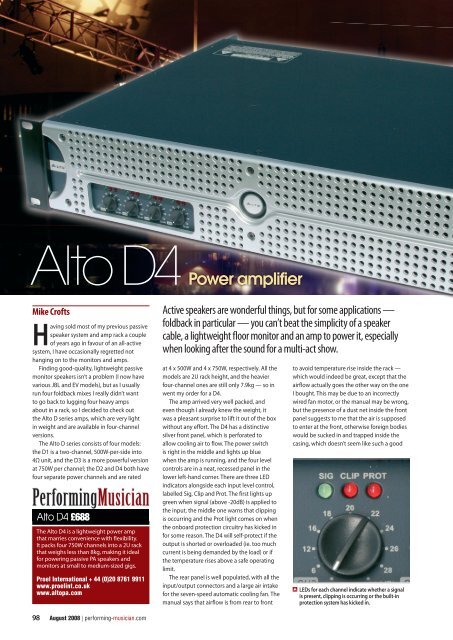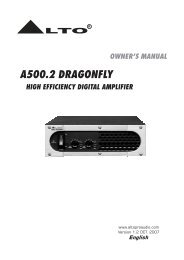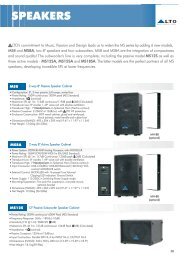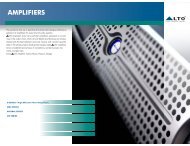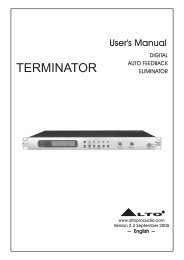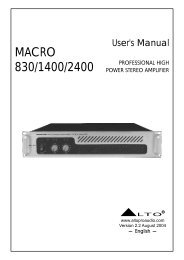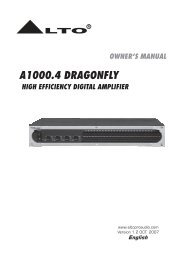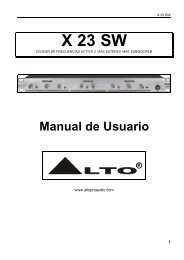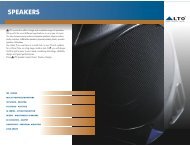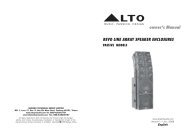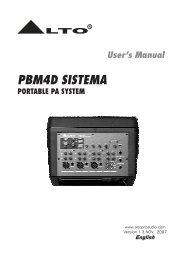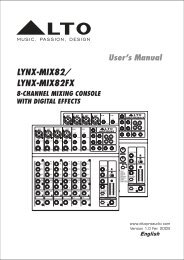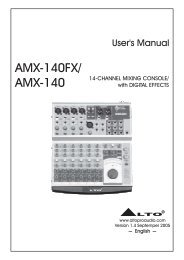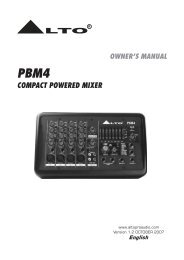Alto D4.indd
Alto D4.indd
Alto D4.indd
You also want an ePaper? Increase the reach of your titles
YUMPU automatically turns print PDFs into web optimized ePapers that Google loves.
<strong>Alto</strong> D4<br />
Power amplifier<br />
Mike Crofts<br />
Having sold most of my previous passive<br />
speaker system and amp rack a couple<br />
of years ago in favour of an all-active<br />
system, I have occasionally regretted not<br />
hanging on to the monitors and amps.<br />
Finding good-quality, lightweight passive<br />
monitor speakers isn’t a problem (I now have<br />
various JBL and EV models), but as I usually<br />
run four foldback mixes I really didn’t want<br />
to go back to lugging four heavy amps<br />
about in a rack, so I decided to check out<br />
the <strong>Alto</strong> D series amps, which are very light<br />
in weight and are available in four-channel<br />
versions.<br />
The <strong>Alto</strong> D series consists of four models:<br />
the D1 is a two-channel, 500W-per-side into<br />
4Ω unit, and the D3 is a more powerful version<br />
at 750W per channel; the D2 and D4 both have<br />
four separate power channels and are rated<br />
PerformingMusician<br />
<strong>Alto</strong> D4 £688<br />
The <strong>Alto</strong> D4 is a lightweight power amp<br />
that marries convenience with flexibility.<br />
It packs four 750W channels into a 2U rack<br />
that weighs less than 8kg, making it ideal<br />
for powering passive PA speakers and<br />
monitors at small to medium-sized gigs.<br />
Proel International + 44 (0)20 8761 9911<br />
www.proelint.co.uk<br />
www.altopa.com<br />
Active speakers are wonderful things, but for some applications —<br />
foldback in particular — you can’t beat the simplicity of a speaker<br />
cable, a lightweight floor monitor and an amp to power it, especially<br />
when looking after the sound for a multi-act show.<br />
at 4 x 500W and 4 x 750W, respectively. All the<br />
models are 2U rack height, and the heavier<br />
four-channel ones are still only 7.9kg — so in<br />
went my order for a D4.<br />
The amp arrived very well packed, and<br />
even though I already knew the weight, it<br />
was a pleasant surprise to lift it out of the box<br />
without any effort. The D4 has a distinctive<br />
silver front panel, which is perforated to<br />
allow cooling air to flow. The power switch<br />
is right in the middle and lights up blue<br />
when the amp is running, and the four level<br />
controls are in a neat, recessed panel in the<br />
lower left-hand corner. There are three LED<br />
indicators alongside each input level control,<br />
labelled Sig, Clip and Prot. The first lights up<br />
green when signal (above -20dB) is applied to<br />
the input, the middle one warns that clipping<br />
is occurring and the Prot light comes on when<br />
the onboard protection circuitry has kicked in<br />
for some reason. The D4 will self-protect if the<br />
output is shorted or overloaded (ie. too much<br />
current is being demanded by the load) or if<br />
the temperature rises above a safe operating<br />
limit.<br />
The rear panel is well populated, with all the<br />
input/output connectors and a large air intake<br />
for the seven-speed automatic cooling fan. The<br />
manual says that airflow is from rear to front<br />
to avoid temperature rise inside the rack —<br />
which would indeed be great, except that the<br />
airflow actually goes the other way on the one<br />
I bought. This may be due to an incorrectly<br />
wired fan motor, or the manual may be wrong,<br />
but the presence of a dust net inside the front<br />
panel suggests to me that the air is supposed<br />
to enter at the front, otherwise foreign bodies<br />
would be sucked in and trapped inside the<br />
casing, which doesn’t seem like such a good<br />
LEDs for each channel indicate whether a signal<br />
is present, clipping is occurring or the built-in<br />
protection system has kicked in.<br />
98 August 2008 | performing-musician.com
idea. Either way, access to the dust net for<br />
cleaning can be gained by removing the six<br />
screws that hold the front panel in place.<br />
A bridged D4<br />
The four inputs are over to the left side as<br />
you look at the rear of the amplifier. The<br />
connectors are of the Combo XLR/jack type,<br />
which is a nice practical feature, and they<br />
are grouped into two pairs with associated<br />
The manual<br />
states that<br />
airflow is from<br />
rear to front,<br />
which would<br />
minimise heating<br />
at the back of<br />
a rack, but in fact<br />
the fan blows air<br />
from the front of<br />
the amp to the<br />
rear.<br />
configuration switches. The various input<br />
options are ‘parallel’, where the inputs are<br />
simply connected together so that anything<br />
connected to either input 1 or 2 will be output<br />
from both channels 1 and 2, and similarly<br />
for channels 3 and 4. In ‘stereo’ mode the<br />
channels are completely independent, which<br />
is how they would be set up for four separate<br />
mixes. Finally, ‘bridged’ mode connects the<br />
first input of each pair (ie. Inputs 1 and 3) to<br />
both channels of that pair operating in bridge<br />
mode, to deliver twice the voltage swing — if<br />
both input switches are set to ‘bridge’ the D4<br />
acts like a stereo amp capable of delivering<br />
1500W per channel into 8Ω loads. It’s worth<br />
checking the position of these little three-way<br />
slider switches before using the amp though,<br />
as it’s possible that they could accidentally<br />
be moved when plugging or unplugging<br />
the input connectors. Alongside each pair of<br />
inputs is another small slider switch, which<br />
introduces a 30Hz high-pass filter, but it only<br />
operates on the two paired channels together,<br />
only convenient but it also eliminates the risk<br />
of using an inappropriate fuse.<br />
Light or Watt?<br />
So far I’m happy with my <strong>Alto</strong> D4, in that it<br />
does the job it was bought for, it seems pretty<br />
well built and, above all, it’s convenient in<br />
terms of space and weight. I have the D4<br />
mounted in a 4U rack case; it’s so light that<br />
I can use the handle on the front lid and carry<br />
it easily with one hand — great for getting<br />
through single doors and reducing the<br />
Tech Spec<br />
D4<br />
• 4-channel power amplifier.<br />
• Frequency response: 20Hz - 20kHz<br />
±0.1dB.<br />
• Input sensitivity @ 4Ω: 1V RMS.<br />
• Input impedance: 10kΩ unbalanced,<br />
20kΩ balanced.<br />
• Clipping point: 10V RMS.<br />
• SNR: 105dBA.<br />
• 4 x 750W @ 4Ω.<br />
• 4 x 370W @ 8Ω.<br />
• 2 x 740W @ 16Ω (bridged mode).<br />
• 2 x 1500W @ 8Ω (bridged mode).<br />
• THD: 1%.<br />
• 30Hz low-pass filter.<br />
• Signal, clip & protection LED<br />
indicators.<br />
• Dimensions (WDH) 483 x 411 x 89mm.<br />
• Weight: 7.9kg.<br />
so you can’t, for example, have the filter<br />
engaged for Channel 1 but not for Channel 2.<br />
In general use this filter would normally be left<br />
switched in, but if you’ve set a high-pass filter<br />
on an external crossover, bear in mind that the<br />
LF roll-off slope will be affected if you leave<br />
this filter in as well.<br />
Over on the other side, beyond the fan<br />
intake, are the output connectors. A choice of<br />
Speakon connectors or standard binding posts<br />
is provided to suit virtually every occasion,<br />
and there is enough space around these to<br />
make connections easily when the amp is<br />
fixed inside a rack. The final detail on the rear<br />
panel is the standard IEC power connector<br />
and the power breaker reset button — if<br />
excessive AC supply current is detected, this<br />
breaker will pop, and can be reset manually<br />
by pushing it in again provided everything<br />
is back to normal. I like this feature — it’s not<br />
The D4 offers a choice of Speakon or binding post<br />
connectors for hooking up your speakers.<br />
number of trips to and from the van. So far<br />
I have only used the D4 ‘live’ with my monitors,<br />
and all I can say is that it drives them very<br />
well with plenty of power to spare. It works<br />
quite happily at 4Ω without getting very<br />
warm, and I haven’t yet heard the fan run up<br />
to a high speed. Although I haven’t yet tried<br />
it in bridged mode I am seriously thinking<br />
about getting another D4 to fill the 2U space<br />
left in the rack — I’ll then have eight channels<br />
of monitor power available for larger gigs, or<br />
I could use the second amp bridged and have<br />
a 3kW main system plus four 750W foldback<br />
channels, with less than 16kg of amps in a 4U<br />
rack! That’s 375 Watts per kilo, or roughly<br />
2.7 grams per Watt — which, as should be<br />
the case with power amps, sounds good to<br />
me.<br />
performing-musician.com | August 2008<br />
99


